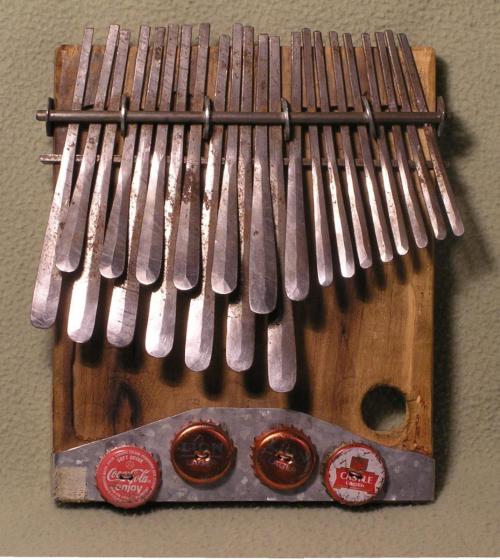
Mbira Music: Fradreck Mujuru and Erica Azim
Zimbabwean master musician Fradreck Mujuru is joined by Erica Azim in playing the healing music of the mbira, used by the Shona to connect the living with the ancestors for more than 1,000 years. Born to the largest extended family of mbira players in Zimbabwe, Mujuru has played mbira since the age of 8, and is now known internationally as an outstanding performer, teacher, and instrument maker, while continuing to play in ceremonies for the ancestors at home. Azim is America’s leading proponent of the Shona mbira tradition, who has toured with various Shona mbira masters and taught thousands of Americans to play mbira, and to support the tradition in Zimbabwe.
3pm, pre-concert talk and 4pm, concert presented by the MIT Center for Art, Science & Technology (CAST) and MIT Music and Theater Arts as part of the 2016-17 MIT Sounding Series.
About the Artists
Fradreck Mujuru and Erica Azim share their passion for traditional forms of Shona music of Zimbabwe through concerts, lecture-demonstrations, and hands-on mbira (thumb piano) workshops. Performer and master craftsman Mujuru is widely considered the greatest living maker of the intricately designed and spiritually potent mbira dzavadzimu (‘thumb piano of the ancestors’). Azim is a respected performer and leading American teacher of Shona mbira music, an entrancing and virtuosic tradition. This 2016 MIT residency is part of Professor Patricia Tang‘s Making African Instruments Project.
Mujuru and Azim began collaborating in 1994 in Zimbabwe, and performed and taught in the US from 2003-2005, followed by an extensive US concert tour in 2014. They play mbira together in a wide variety of tunings, including the low-pitched Dambatsoko tuning traditionally played by the Mujuru family, the low-pitched Phrygian mode nemakonde tuning, the high pitched Dorian-mode Katsanzaira tuning, and the more common nyamaropa and mavembe (gandanga) tunings. Mujuru and Azim also support and promote traditional mbira music and culture in Zimbabwe through the non-profit organization MBIRA, which Azim founded and directs. (MBIRA has paid 19 Zimbabwean mbira makers over half a million dollars for their instruments sold since 1998.)
Mujuru, who hails from the largest extended family of mbira players in Zimbabwe, has played the instrument since the age of 8. After touring Europe and South Africa in the 1990’s, he taught and performed in the US, including residencies at Grinnell and Williams Colleges in 2001, and the University of Michigan in 2012. Mujuru teaches mbira, drums and singing. At home, he plays mbira in traditional ceremonies, builds the instruments with his apprentices, hosts numerous international student musicians, and facilitates the Zimbabwe operations of two small non-profit organizations, including MBIRA. Mujuru plays the songs and the style that have been used heal the sick and call ancestors to earth to give advice to the living, from time immemorial.
California native Azim has played Shona mbira music for over 40 years. She has lived and studied in Zimbabwe, and played on commercial solo mbira recordings, as well as recording and touring with Zimbabwean musicians. She has played mbira at venues, ranging from Zimbabwean village ceremonies to the Kennedy Center in Washington, DC. Azim conducts regional mbira workshops throughout the US and Canada, and holds internationally-attended mbira camps in California, Argentina, Bali, Germany, and Zimbabwe.
The Mbira: Instrument and Music
Zimbabwe’s mbira “dzavadzimu,” the primary traditional instrument of the Shona people, has been played for over 1,000 years for religious rituals, royal courts, and social occasions. It consists of 22 to 28 metal keys mounted on a hardwood soundboard and is usually placed inside a large calabash resonator (deze). The keys are played with the two thumbs plucking down and the right forefinger plucking up.
An mbira piece consists of a basic cyclical pattern which includes numerous intertwined melodies, often with contrasting rhythms. The extensive possibilities for rhythmic and melodic variation render each performance unique. When two mbiras are played together, the interlocking parts result in rich polyphony and polyrhythm.
A traditional repertoire of hundreds of pieces is transmitted from generation to generation, and pieces popular today are known to have been played over 700 years ago. At traditional ceremonies (mapira), ancestors are called by performing their favorite songs; thus, the same pieces are retained in the repertoire over the centuries.
Mbira is played in many traditional and contemporary contexts, including mapira, personal meditation, traditional healing, celebrations and ceremonies. Some of Zimbabwe’s electric pop and fusion bands also incorporate mbira in their music, and the mbira is now considered the national instrument of Zimbabwe.
Learn more about Fradreck Mujuru
Learn more about Erica Azim
The 2016-17 MIT Sounding Series is presented by the MIT Center for Art, Science & Technology (CAST) and MIT Music and Theater Arts.





